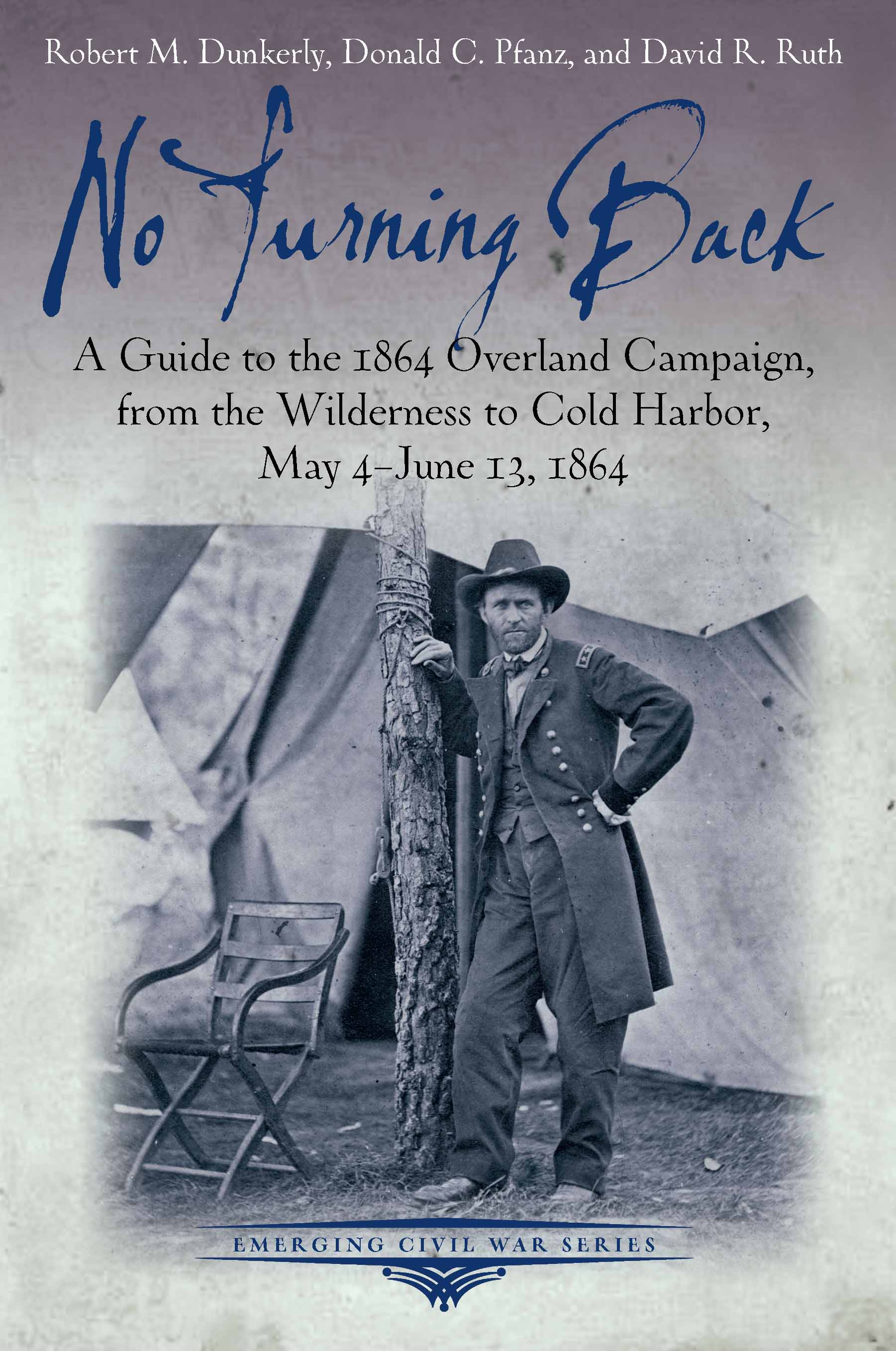The “Emerging Civil War Series” Series: No Turning Back

From co-author Donald Pfanz
When I was a boy, my parents took me on vacations to visit places important in our nation’s history. Later, as I grew older, I began visiting historic sites on my own. There is something special about standing on the spots where great events happened. This is particularly true of battlefields, the places where men fought and died to decide the great issues of their day. Tour guides are important, for they not only tell readers what happened but direct them to places where it happened.
I relished collaborating with my friends Dave Ruth and Bert Dunkerly on No Turning Back, because it allowed me to do something I enjoy: share the story of the people and events that shaped our nation’s history. It was, without question, the easiest book I have ever written, because I was able to draw upon my knowledge of the ground and upon tours I had conducted about the Battles of the Wilderness and Spotsylvania Court House during my career as an historian with the National Park Service. I hope that the book will not only inspire the public to visit landmarks of our past but also to join groups like the American Battlefield Trust and the Central Virginia Battlefields Trust in saving them from development so that future generations of Americans can enjoy them too.
From co-author David Ruth:
More than two decades ago, the Virginia Civil War Trails program was initiated. As part of this effort, dozens of markers were erected that followed the 1864 Overland Campaign from the Wilderness to the James River. These proved to be extremely popular for visitors who wished to follow the path of that extraordinary story. However, as great as the markers were, what was missing was a comprehensive guide that filled in the gaps and provided essential context to historic locations along the trail route. The commemoration of the Civil War Sesquicentennial, combined with Chris Mackowski’s successful Emerging Civil War series, provided the incentive for the authors (the Pfanz, Dunkerly and Ruth team) to produce this missing piece of scholarship in our book, “No Turning Back.”
For me, the most rewarding aspect to the project was adding the back country trail route that identified important sites that needed to be incorporated in the book; in particular, the movements of the Union army through Caroline, King William and Hanover counties, which previous historians had merely touched on. And sitting in the pews of Bethel and Mangohick Churches, and in the parlor of historian Dorothy Atkinson’s home, the 18th century Wyoming, and listening as she shared her knowledge of the historic roads and the passing of the army were experiences that are forever ingrained in my memory. Lastly, seeing the guide actively being used by visitors made me realize that this effort was indeed worthwhile and important.
From co-author Bert Dunkerly:
As historians we often focus on the battles but not how the armies got there. By analyzing the routes we see how the armies moved and the decisions made along the way between battles. This reveals that we often have assumptions about campaigns and battles that may not be true. Things could have developed differently and following the details of army movements shows that. We can also better understand the decisions commanders made by looking at how the armies moved, the obstacles they faced, and the options that generals had. It was a wonderful experience to work with two outstanding historians on this project. Thankfully this is a very drivable campaign, and numerous historic sites exist to see as one does the tour.
* * *
Editor’s Note (from Chris):
Here we were, only seven books into the series and we had one that wanted to break the template we were trying so hard to establish! However, Don Pfanz is a dear friend, and I really wanted to find a way to make things work with his book when he brought it to me. I’d never met Dave before, and I’d only met Bert in passing at a couple NPS events, but I certainly knew their excellent reputations, so the chance to work with them was another big draw for me with this project.
Short story: we decided we’d give a guide book a try. We had to adapt our overall format, but since I was still doing the layout on all the books at the time, it was easy enough for me to mold things so that the book still had the ECW “feel” we’d established while still showing of the tour to its best advantage.
I drove the tour myself twice to double-check directions, and I found it to be an excellent way to explore the Overland Campaign. I became a really big fan of this book!
It turned out that the tour guide format wasn’t all that strange to us. After all, our books all had tour components to them thus far, so No Turning Back really just became a natural extension of that.
————
No Turning Back: A Guide to the 1864 Overland Campaign, from the Wilderness to Cold Harbor, May 4-June 13, 1864
by Robert “Bert” Dunkerly, Donald C. Pfanz, and David R. Ruth
Click here to read more about the book, including a book description, reviews, and author bios.

1 Response to The “Emerging Civil War Series” Series: No Turning Back